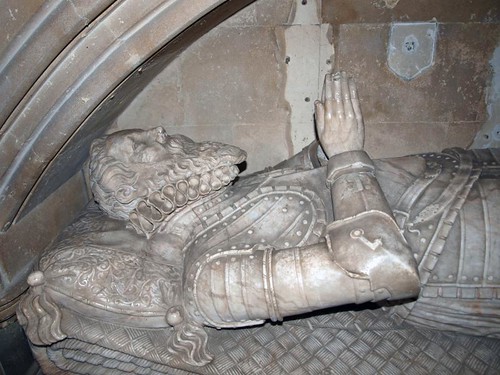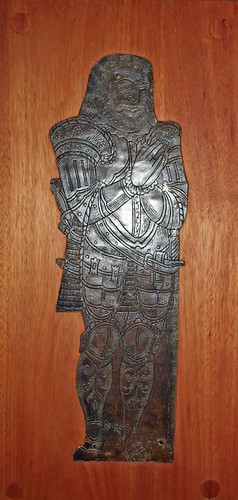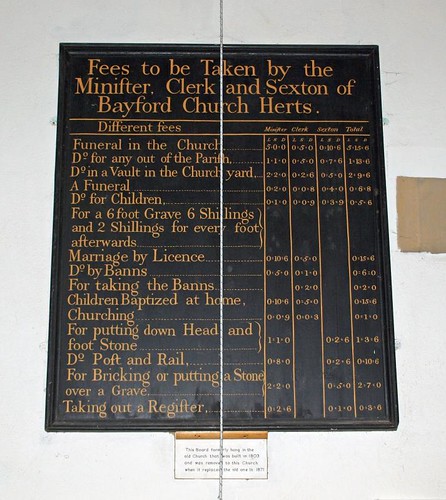My real joy here was Colin, who came to lock up earlier than usual - luckily he came in to the church to check it was empty before locking up - who said that they had only been keeping the church open for about a year, that it had been a great success with lots of visitors and finished off by saying what is the point of having a church if you're going to keep it locked? Hear, hear...we need more Colins in this day and age.
ST MARY. 1870, by Woodyer. Stone, in the E.E. style, with brick quoins and a fleche. The S vestry roof is the nave and chancel roof carried lower down without a break (a happy effect). - F ONT. Perp, octagonal with simple tracery and quatrefoil motifs. - MONUMENTS. George Knighton d. 1612, excellent recumbent marble effigy in armour. Let into the back wall the brasses of two men in armour, c. 1550 and c. 1590.
Bayford. From the village pond the road bends down to the handsome lychgate of a churchyard where junipers, pines, and yews show up darkly against the elms in the meadows and the lofty oak across the way. Here under the churchyard trees lies William Yarrell, whose books on British fishes and birds were long the best books of their kind. This London bookseller took every opportunity of accumulating knowledge about our birds and fishes and in writing about them with such accurate simplicity that his books are still read after a century. He was born in 1784, and he lies here in his mother’s village, while his medallion portrait is in the Piccadilly church of St James’s, and his oil portrait is treasured by the Linnean Society, whose treasurer and vice-president he was till he died. Those who make this naturalist’s grave a place of spring-time pilgrimage will hear a grand chorus of birds from the deep woods stretching for miles behind these cottages above the Lea Valley; but they can scarcely hope for his good fortune in seeing, as he did at Therfield, the rare rock thrush. It came in the spring of 1843, but has never been seen wild in England since.
Bayford’s church is new since Yarrell’s day, but it keeps the rose-carved Tudor font, the brasses, and a marble figure from the old one. Two of the brasses are portraits of 16th-century knights, the palimpsest one sketched on the back of part of a shrouded figure thought to be that of John Knightson, whose descendant George appears in the same recess, a white armoured figure of 1612 in ruff, trunk hose, and jackboots. In his day the manor house was built, and though many alterations were made last century the old stairs still climb the three storeys in six flights, one above the other, and in one of the rooms is some painted panelling.
Bayfordbury, the great house here, stands in grounds remarkable for their trees, three cedars forming a magnificent group about 100 feet high. The house has classical porticos on both sides and is famous for its portraits of members of the Kit Cat Club, which were painted by Sir Godfrey Kneller.
Bayford’s church is new since Yarrell’s day, but it keeps the rose-carved Tudor font, the brasses, and a marble figure from the old one. Two of the brasses are portraits of 16th-century knights, the palimpsest one sketched on the back of part of a shrouded figure thought to be that of John Knightson, whose descendant George appears in the same recess, a white armoured figure of 1612 in ruff, trunk hose, and jackboots. In his day the manor house was built, and though many alterations were made last century the old stairs still climb the three storeys in six flights, one above the other, and in one of the rooms is some painted panelling.
Bayfordbury, the great house here, stands in grounds remarkable for their trees, three cedars forming a magnificent group about 100 feet high. The house has classical porticos on both sides and is famous for its portraits of members of the Kit Cat Club, which were painted by Sir Godfrey Kneller.



No comments:
Post a Comment